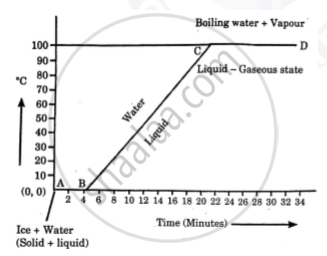Advertisements
Advertisements
प्रश्न
उत्तर
APPEARS IN
संबंधित प्रश्न
What is the Greenhouse effect?
1 g ice of 0℃ melts to form 1 g water at 0℃. State whether the latent heat is absorbed or given out by ice.
A molten metal of mass 150 g is kept at its melting point 800℃. When it is allowed to freeze at the same temperature, it gives out 75,000 J of heat energy.
- What is the specific latent heat of the metal?
- If the specific heat capacity of metal is 200 J kg-1 K-1, how much additional heat energy will the metal give out in cooling to -50℃?
Calculate the total amount of heat energy required to convert 100 g of ice at −10℃ completely into water at 100℃. Specific heat capacity of ice = 2.1 J g-1 K-1, specific heat capacity of water = 4.2 J g-1K-1, specific latent heat of ice = 336 J g-1.
Answer the following:
Explain the role of latent heat in the change of state of a substance.
When a liquid is getting converted into solid, the latent heat is ………………………………
Explain the following temperature Vs. time graph:

Define specific latent heat of vaporization of a substance.
Name two factors on which the heat absorbed or given out by a body depends.
What happens to the heat supplied to a substance when the heat supplied causes no change in the temperature of the substance?
1 kg of water is contained in a 1.25 kW kettle. Assuming specific heat capacity of water = 4.2 J/g °C and specific latent heat of vaporization = 2260 J/g, calculate:
(i) the time taken for the temperature of water to rise from 25°C to its boiling point,
(ii) the mass of water which evaporates per minute from the boiling water.
When ice is converted into water : constant temperature : : before the water evaporates : _______
Find the odd one out and give its explanation.
Write the name.
Products obtained when sugar is heated.
The latent heat of vaporisation is a term referred for the conversion of gas into liquid.
1 kg of dry air at a temperature of 40 °C can hold a maximum of 49 g of water vapour.
Specific latent heat L = ______.
2875 J of heat is required to melt 115 g of lead at its melting point. Calculate the specific latent heat capacity of fusion of lead.
Observe the following graph and answer the following questions:

- What does the graph represent?
- What does the line AB represent?
- What does the line BC represent?
